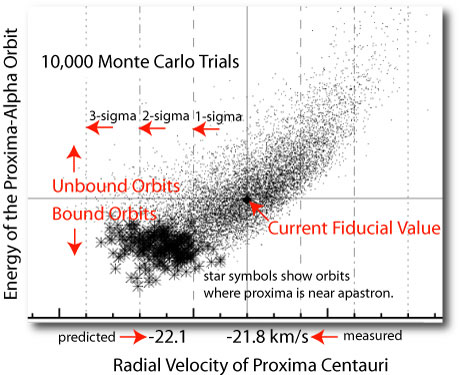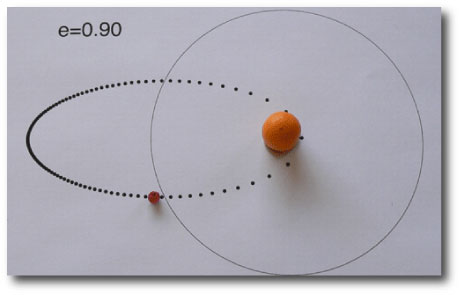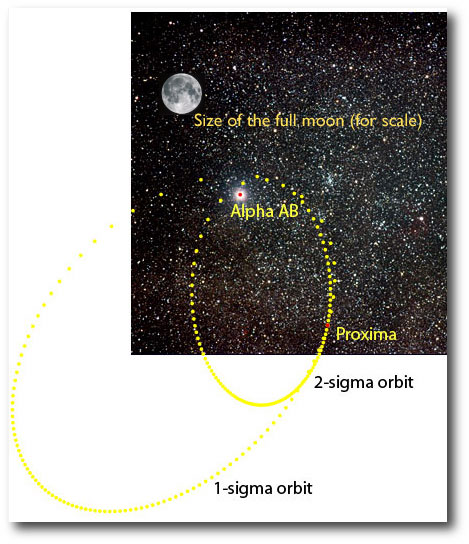
Image source.
Last week, I wrote about a plan to send a tiny spacecraft on a trip to the vicinity of Alpha and Proxima Centauri. The idea is to employ a multi-stage rocket to boost a tiny payload toward the stellar system at high speed. When the destination is reached, the principle of gravity de-assist (in the form of successive close flybys of the stars) is used to haul the spacecraft into a bound orbit without using any on-board fuel. [This, of course, is an exercise in orbital dynamics, and not mission proposal. There are better ways to get to Alpha Centauri.]
The problem was tackled by UCSC graduate student Jeremy Wertheimer as his term project for my Astrophysical Dynamics class. Our initial plan was to use a multiparameter minimization scheme (such as the genetic algorithm or simulated annealing) to vary the incoming trajectory of the spacecraft until we found the largest arrival speed that allows for a final bound orbit. To do this requires us to have a precise orbital model for the Alpha AB — Proxima trio.
Amazingly, we discovered that the most recent papers in the literature (from the early 1990s) had arrived at the conclusion that Proxima Centauri is not bound to the Alpha Centauri binary, but rather is in the process of merely drifting past them like a ship in the night. The a-priori odds of Proxima being so close, and so nearly bound, are less than one in a million, but nevertheless, the best position and velocity measurements at that time suggested that this was indeed the case.
In the intervening years since the Matthews & Gilmore 1993 and Anosova et al. 1994 Proxima-Alpha papers were published, there has been a tremendous improvement in our knowledge of the positions, distances, and space velocities of the nearby stars. This improvement is largely due to the European Space Agency’s Hipparcos astrometric satellite, which flew between November 1989 and March 1993 (and whose data was published in June 1997). Hipparcos obtained excellent 3D positional and plane-of-the-sky velocity measurements for both Alpha and Proxima Centauri. When combined with mass and radial velocity measurements for the three stars, the Hipparcos data allows a much better determination of the orbit.
When Jeremy computed an orbit for Proxima using the updated Hipparcos data, he discovered that the measurements now suggest that Proxima Centauri is just barely bound to the Alpha AB pair. He found an enormous elliptical orbit with semi-major axis 272212 AU. (This works out to a whopping 4.3 light years, which is coincidently quite close to the current Sun-Proxima distance.) Clearly, this orbit is much too large, but it’s encouraging to see that the centroid kinematic measurements now indicate that Proxima is formally bound to Alpha.
Even the latest measurements for the Proxima-Alpha Centauri positions and velocities contain uncertainties. In particular, it turns out that the absolute radial velocity for Proxima Centauri has a (still surprisingly large) 1-sigma uncertainty of 200 meters per second. Proxima’s radial velocity in turn has an important effect on whether the three stars are gravitationally bound. Jeremy ran a Monte Carlo simulation in which he drew 10,000 models of the Proxima-Alpha system parameters from the Gaussian distributions implied by the uncertainties in the observations. When he plots the binding energy of these models against the value for Proxima’s radial velocity, he finds that 44% of the trial systems are bound (that is have total energy = gravitational energy + kinetic energy less than zero).

Many of the bound trial systems have energies very close to zero, and hence place Proxima in absurdly large orbits around Alpha. In these configurations, Proxima is currently at the periastron (that is, the near-point) of its orbit. An object in a highly eccentric orbit, on the other hand, spends most of its time near apastron (the orbital far-point).
To illustrate how objects tend to spend their time near apastron, here’s a home-made mpeg-4 stop-action animation of a peppercorn orbiting a kumquat in an ellipse with e=0.90. (Try this version if the other one loads a screen of gibberish).
 .
.
If Proxima is indeed bound to Alpha, then we would (a-priori) expect to find it near apastron. In the figure above, the Monte-Carlo generated orbits in which Proxima is close to apastron have been marked with stars. These orbits all fall in the part of the graph where Proxima’s radial velocity is in the vicinity of -22.1 kilometers per second. We thus have a prediction: if Proxima’s radial velocity is measured to high accuracy, then the value will be ~-22.1 kilometers per second, rather than the current value of ~-21.8 kilometers per second.
In the figure below, I’ve plotted two of the Monte-Carlo orbits for Proxima with respect to Alpha. The “two sigma” orbit is an example of a realization in which Proxima is slightly closer to apastron than periastron. The orbits are projected onto the plane of the sky, and superimposed on an actual photograph of Centaurus (with the full Moon digitally superimposed to give a sense of scale). If our analysis is correct, it should take Proxima about a million years to make one orbit of Alpha, and the semi-major axis of the orbit should be about 1/6th of a light year:


Hi Greg
Vernor Vinge wrote a short story a few years ago called “Long Shot” which involved a multistage, 10,000 year mission to Alpha Cen – I read it in an anthology called “Explorers”. From what I can gather he was trying for a similar orbit to the project you gave your students. Considering his non-fictional work in astrodynamics I’d say he probably figured it out also.
Adam
Pingback: systemic - Earth. Ground. Inexpensive. Soon.
Pingback: systemic - speculations
Pingback: systemic - A Miss is as Good as a Mile
Pingback: systemic - Toward Alpha Cen B b